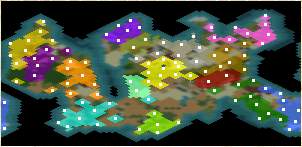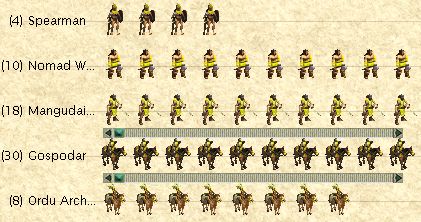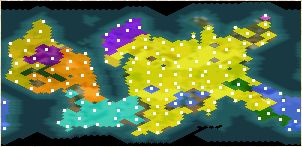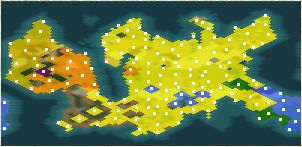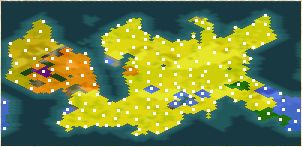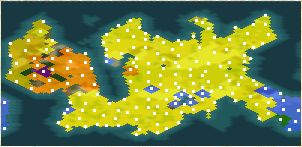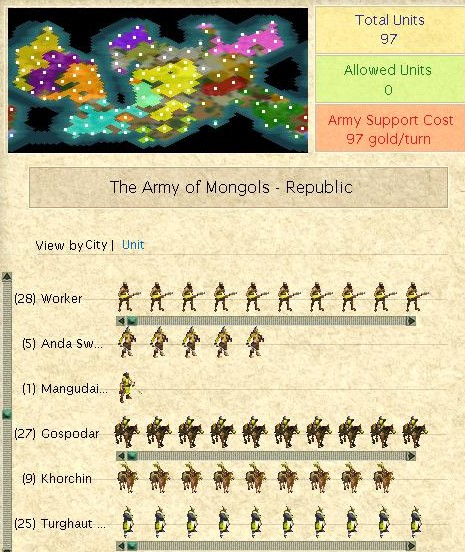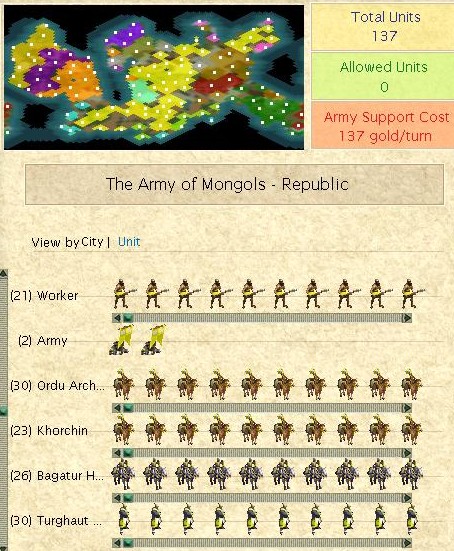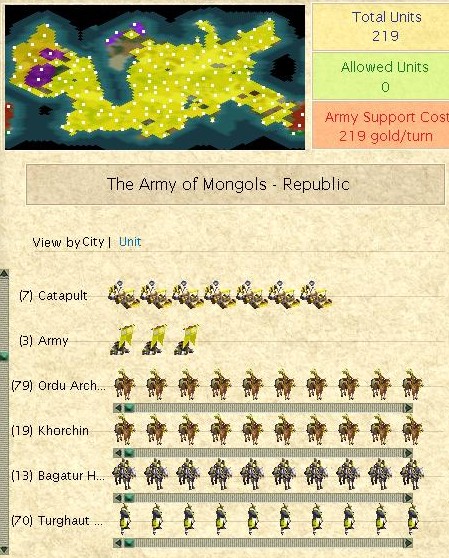Mac 1.29
975 BC 10 BC: THE LONG PREP FOR WAR
In 975 BC the Mongols entered the Middle Ages with 12 cities, 11 workers, 21 military units, and 1786g.
Germany had built the Pyramids, and the nearby minor civs built no wonders worth fighting for. The Magog built a second wonder the turn before acquiring literature, and I was hoping they would build the Library in time. They didnt, and the lack of a nearby useful wonder or large numbers of captured slaves offered no reason or tools to launch a premature war that might have generated Leaders. I was frustrated, but felt I had no choice except to focus my resources along a less aggressive path.
Because both monotheism and engineering were already discovered, and the AI could research faster than me, my options were to either blow my gold on both techs, then research invention, or save even more gold until monotheism was also discovered. I chose the latter.
In 510 BC, one turn after the Ottomans researched feudalism, I traded the Ottomans 50 gpt for feudalism and 202g. Engineering and monotheism cost me a net 107g. I then declared war on the Ottomans, canceling the gpt, for a final net gain of all three techs and 95g for one lousy ruined reputation. I then allied with the Han against the Ottomans, insuring I wouldnt be attacked, and declared war on Germany then allied with the Kelts, because both were getting too big. One turn later, the Ottomans built the Library, leaving me on my own for research. Invention was due in 20 turns.
In 410 BC two Turghaut Cavalry built to kick off my GA did so against an isolated Ottoman town. My biggest cities built markets. Research picked up, and I built a very tight core around my FP (which was right next to the capital) that eventually totalled 18 cities. The capital built settlers, a few others built workers, one prebuilt Leos, and the rest pumped out Ordu Archers, Korchins, and Turghaut Cavalry in a formula I worked out in the pre-game.
Over the centuries, more civs joined the two wars I started, and I pulled the Tokugawa in against the Ottomans as the Han made no headway. In 50 BC, I researched invention, built Leos, and upgraded to 16 Turghaut, 13 Korchin, and 46 Ordu. My cities then switched to making Bagatur Hordes, and continued to do so for the next 570 years.
10 AD 770 AD: THE MOUNTED CHARGE TO DOMINATION
My plan was to quickly jump my capital in Khazar territory, and fight a rolling two-front war. The northern force would take the Khazars, Russians, Arabs, Raj and Goguryeo in a big U-shaped swing. The southern force would take the Magog, followed by Persia, then kick back for the Kelts before joining with the rest of my units for what promised to be the tough fight: the Han, who blocked the route to the western peninsula. My intent was to avoid the Egyptians, Germans, and possibly Korea.
My GA ended just as I went to war to the east with weak Russia en route to the Khazars, and to the west against the Magog. One turn later I declared war on the Khazars. At the same time, one of my productive cities flipped to the Rajaputanis the first of several to come. The Khazars were out by 50 AD, and I jumped my palace to Balkhash with my first Leader on the next turn, as the Magog also expired. I also declared war on Korea this turn, because their lone city south of my core caused one of mine to flip to them! I took both cities, then made peace with Korea in 150 AD.
The force that knocked off the Magog now moved south against the Khwarismians. After destroying two small towns, my combined-arms approach hit a wall here, as the Khwarizmian pikemen, defending cities on hills, and backed by counterattacking knights and MI, gave ground slowly. In 230 AD I made peace with Persia in exchange for Susa, to give myself a chance to reload. (Captured Arbela then flipped a couple of turns later.)
In 210 AD I built Bachs with another Leader. One turn later, with Russia reeling, I declared war on the Arabs. The Raj were far more troublesome due to their culture, but I wanted my troops to always fight the closest civ, and avoid wheeling back and forth. The Russians were out by 270 AD, and I focused on an opponent I was worried about: the Arabs. By now they had some musketmen and lots of pikes, but oddly, only longbowmen for offense. I attacked with one main force, while a smaller one picked off their northern peninsular cities. Playing patiently, I bombarded them down to the red before attacking, and made steady headway northeast.
The Han, aided by the Tokugawa, had finally cracked the Ottoman lines in a war started in 510 BC. In 310 AD, I declared proxy war on Korea and allied with the Raj and Goguryeo, hoping to lure the Raj offensive units west before I finished the Arabs and hit them from the east. At the same time, I renewed hostilities against the Khwarizmians. With fresh Bagatur Hordes, the Khwarizmians were eliminated the same year as the Arabs: 380 AD.
In this period, two more of my productive cities flipped to the Raj, including one on my southern border. My strategy throughout the game was to leave captured cities empty until the war was over, then use a limited number of units to pacify them, after which I rushed temples. As I positioned the conquerors of Arabia to invade the Raj, however, I decided to raze the large eastern cities, as I felt theyd be certain to flip. It would be easy enough to settle these areas myself, since there were no competitors left in the area.
In 420 AD I attacked the Raj from the east, keeping several Bagatur in the west to guard against strikes from Raj units fighting Korea. The Raj surprised me by counterattacking with cavalry! I quickly made peace with Korea, and developed a revised strategy against the Raj. First I knocked out their horse and iron links. I razed two major cities in the east, but left the little ones undefended, which drew out the Rajs few cavalry (most had died fighting Korea, I guess). Their cavalry would take an empty town, and I would retake it with reinforcements, killing the cavalry at the same time. The Raj cities were lightly defended, validating my strategy of drawing them into an early war on the opposite side from where I would attack. As a result, my "knights" overwhelmed their cavalry, and the Rak fell shockingly fast: 500 AD.
I took stock. The Mongols controlled less than half the world, and I had already encountered cavalry. I wasnt going to win without it. I had already picked up gunpowder in a broken peace deal, and now made peace with the Tokugawa, paying 590g for metallurgy. I then set research on military tradition, due in six turns. My cities had already begun building Ordu Archers in anticipation of a mass cavalry upgrade. My plan was to invade the Han with all my cavalry and push all the way up to Egypt, while my obsolete mounted units consolidated in the southeast. These units had been picking off the northwesternmost German cities, as the Kelts had begun to collapse in a war that had been raging for 1000 years. In 510 AD, I made peace with Germany, declared war on the Kelts and blitzkrieged them out of existence in three turns. In the northwest, one obsolete combined force was taking the three Goguryeo cities one at a time.
In 590 AD, Korea declared war on the Goguryeo, revealing that it, too, had cavalry. But now, so did the Mongols. 32 cavalry slammed into the Hans soft eastern borders they were on the verge of crushing the Ottomans and Tokugawa to the northwest and took five cities the first turn. China had two defenders per city: muskets, pikes, and spears. Occasionally a cavalry unit and one cav army! - would work its way back from the northern wars, but their eastern half collapsed amazingly quickly: three cities on the next turn, three the next two turns, before I paused to heal.
In 650 AD, as I nervously noted that all the civs except Germany had entered the industrial era, I was ready to strike Germany. 15 knights were riding through the old Kelt lands en route to the Tokugawan front. I ambushed them on open ground with 36 Bagaturs and 6 Korchin, and wiped them out. The invasion of Germany then began in earnest. It progressed more slowly, as expected, as the Bagatur force faced two to three defenders per city musket and pike as well as the odd knight, longbowman and MI.
A nine-strong Korean cavalry force, also en route to the Tokugawa, turned around when the Tokugawa fell to Egypt and the Han. By now the Han had been reduced to its Ottoman holdings, and I had begun to divert cavalry back toward Korea. I caught the Korean cavalry near their border and staged a second massacre. I then invaded Korea with the returning cavalry and two Bagatur armies, and experienced only one stray counterattack. This was a relief, given my discovery that the Koreans had
riflemen!
Fortunately, I knew I was in the end game. The Han were eliminated in 700 AD, and I left eight cavalry in the west to take out the three scattered Ottoman cities, and pacify what unrest still existed. The Korean cities were all defended by two units, of which half were rifles, and these fell steadily. The war against Germany picked up steam as I sent a cavalry army there to deliver the hammer after my depleted obsolete units did their bombarding. They were down to five cities, and the Koreans to two, when domination was reached in 770 AD.
In summary, I pursued my usual domination/conquest strategy of building almost nothing but barracks, except temples in conquered cities. My early efforts were limited by a lack of foreign workers and no wonders or leaders. I am still not sure if waiting until 10 BC to start to go on the offensive was the best strategic choice. I didnt see the point of warring with ancient units against Predator opponents, and I couldnt blow past the AI in research. However, I was pretty happy with the way I dominated the map from my core in 10 BC to the 67% point in 770 AD. I employed my usual offensive strategy:
1. Weaken the enemy by first allying with them in proxy wars that take their units away from our border.
2. Make the first targets resource denial whenever possible.
3. Draw out the enemy offensive units into open ground early and ambush them.
4. Plan all the wars at once, so that my invading units next target is next door, minimizing regrouping.
5. Whenever possible, fight two wars or more wars simultaneously.
6. Employ only "just enough" units to accomplish this. Once an enemys back is broken, send the bulk of your army on to the next opponent, leaving a small force to finish off the original opponent. The goal is that the second opponent is finished off that much sooner, and the first opponent goes down no later. (This makes more sense for fast finish than higher score, but I only play for fast finish.)
 )
) )
)
 Civ_Steve, you're right. (thanks to whoever moved this)
Civ_Steve, you're right. (thanks to whoever moved this)

![Mac Civ3 Icon [civ3mac] [civ3mac]](/images/smilies/macciv3.gif) 1.29b2 Open
1.29b2 Open .
.
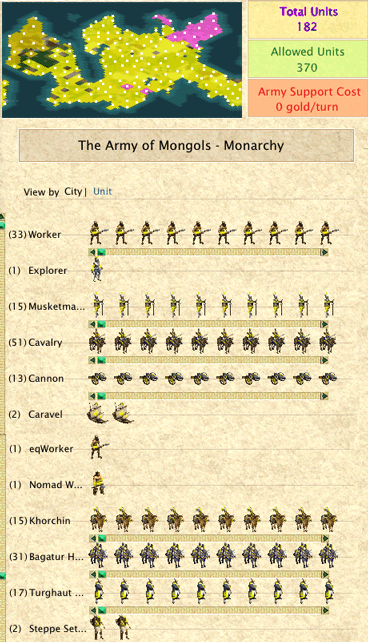



 . "GL" requires three FTKs - shift-G-L, or four if you can't coordinate sufficiently to use the same shift key operation to cover both letters. If you are so seriously short of time that two or three extra FTKs at a couple of points in your timeline blow it for you then what the #$@& are you doing playing at all?
. "GL" requires three FTKs - shift-G-L, or four if you can't coordinate sufficiently to use the same shift key operation to cover both letters. If you are so seriously short of time that two or three extra FTKs at a couple of points in your timeline blow it for you then what the #$@& are you doing playing at all?![PTW Icon [ptw] [ptw]](/images/smilies/ptw.gif) 1.27f (Euro), Open Class
1.27f (Euro), Open Class